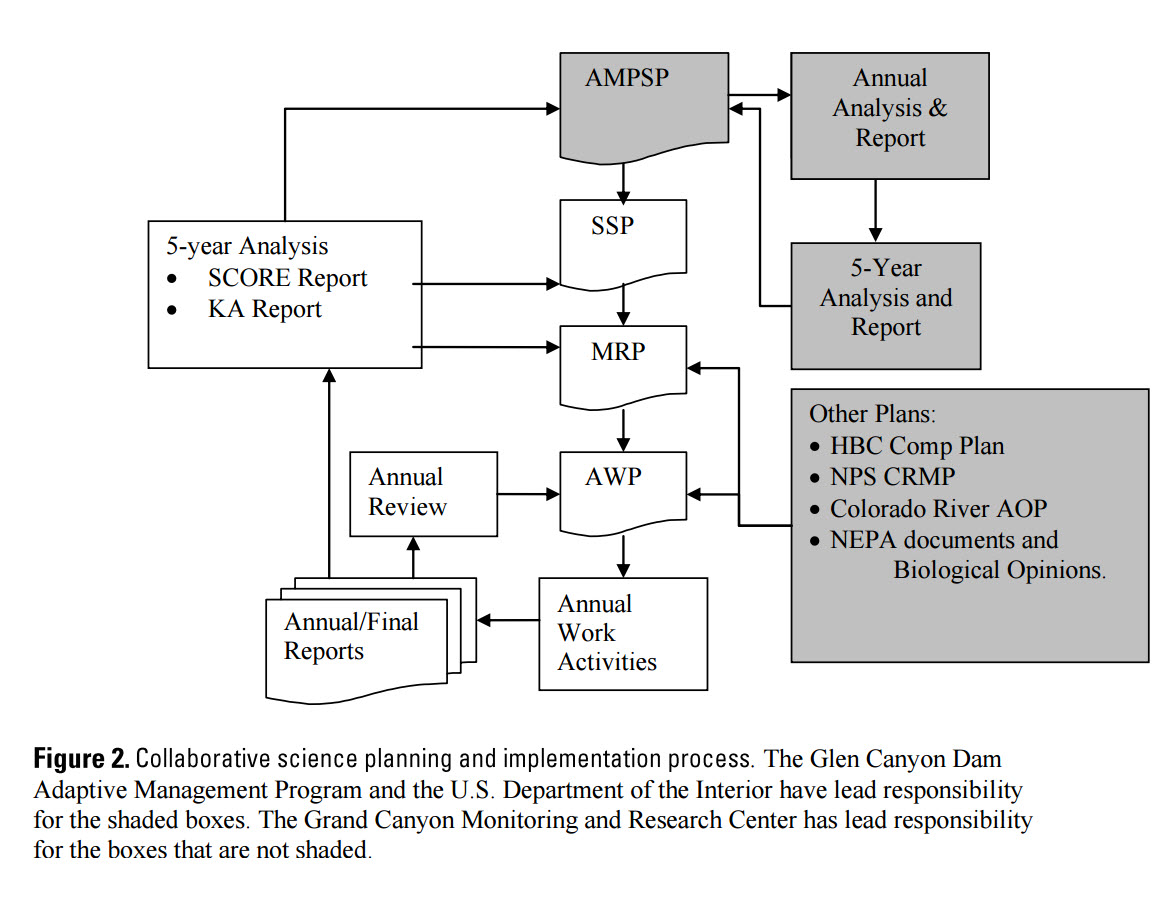Difference between revisions of "GCDAMP Planning"
Cellsworth (Talk | contribs) |
Cellsworth (Talk | contribs) |
||
| Line 76: | Line 76: | ||
*We do so in keeping with the federal trust responsibilities to Indian tribes, in compliance with applicable federal, state, and tribal laws, including the water delivery obligations of the Law of the River, and with due consideration to the economic value of power resources. | *We do so in keeping with the federal trust responsibilities to Indian tribes, in compliance with applicable federal, state, and tribal laws, including the water delivery obligations of the Law of the River, and with due consideration to the economic value of power resources. | ||
| − | *This will be accomplished through our long-term partnership utilizing the best available scientific and other information through an adaptive ecosystem management process. | + | *This will be accomplished through our long-term partnership utilizing the best available scientific and other information through an adaptive ecosystem management process. [http://www.riversimulator.org/Resources/GCDAMP/GCDAMPchronicle/StrategicPlanGCDamp2001.pdf] |
==''' Principles ''' == | ==''' Principles ''' == | ||
| Line 88: | Line 88: | ||
# Because management actions to achieve a goal may benefit one resource or value and adversely affect another, those action alternatives that benefit all resources and values will be pursued first. When this is not possible, actions that have a neutral impact, or as a last resort, actions that minimize negative impacts on other resources, will be pursued consistent with the Glen Canyon Dam Environmental Impact Statement and the Record of Decision. | # Because management actions to achieve a goal may benefit one resource or value and adversely affect another, those action alternatives that benefit all resources and values will be pursued first. When this is not possible, actions that have a neutral impact, or as a last resort, actions that minimize negative impacts on other resources, will be pursued consistent with the Glen Canyon Dam Environmental Impact Statement and the Record of Decision. | ||
# If the target of a management objective proves to be inappropriate, unrealistic, or unattainable, the Adaptive Management Program will reevaluate that target and the methods used to attain it. | # If the target of a management objective proves to be inappropriate, unrealistic, or unattainable, the Adaptive Management Program will reevaluate that target and the methods used to attain it. | ||
| − | # Recognizing the diverse perspectives and spiritual values of the stakeholders, the unique aesthetic value of the Grand Canyon will be respected and enhanced. | + | # Recognizing the diverse perspectives and spiritual values of the stakeholders, the unique aesthetic value of the Grand Canyon will be respected and enhanced. [http://www.riversimulator.org/Resources/GCDAMP/GCDAMPchronicle/StrategicPlanGCDamp2001.pdf] |
==''' GCDAMP Goals ''' == | ==''' GCDAMP Goals ''' == | ||
Revision as of 12:08, 9 May 2018
|
|
Mission, Principles, Objectives, and PlanningThe GCDAMP is based on an adaptive environmental assessment and management (AEAM) approach to natural resources management (Holling, 1978; Walters, 1986), now commonly called ―adaptive management. The approach assumes that managed natural resources will always change, that scientific understanding of ecosystems is constantly improving, and that natural resource managers need the best available information to make decisions. AEAM unites the strengths of different scientific disciplines to meet the information needs of resource managers. It encourages scientists and managers to work collaboratively to use scientific information in the management process. AEAM consists of two parts—adaptive assessment and adaptive management. Assessment investigates how ecological systems work and evaluates management alternatives to achieve goals. Management involves learning by doing and testing, which may include monitoring system responses to natural changes (passive adaptive management) or deliberate manipulation of key processes (active adaptive management). Adaptive management acknowledges that policies must satisfy social objectives, but policies also need to adapt to both changes in understanding and changes in managed systems. Managers using an AEAM approach learn how a natural system works and how their actions affect the system; this knowledge helps them to perform better in complex and uncertain environments. |
| GCDAMP Strategic Plan The GCDAMP Strategic Plan (AMPSP) is a long-term plan drafted in August 2001 by GCDAMP and GCMRC participants that identifies the AMWG’s vision, mission, principles, goals, management objectives, information needs, and management actions. |
Strategic Science Plan The GCMRC Strategic Science Plan (SSP) identifies general strategies for the next 5 years to provide science information responsive to the goals, management objectives, and priority questions as described in the AMPSP and other planning direction approved by the AMWG. |
Core Monitoring Plan The GCMRC Core Monitoring Plan (CMP) describes the consistent, long-term, repeated measurements using scientifically accepted protocols to measure status and trends of key resources to answer specific questions. Core monitoring is implemented on a fixed schedule regardless of budget or other circumstances (for example, water year, experimental flows, temperature control, stocking strategy, nonnative control, etc.) affecting target resources. |
Monitoring and Research Plan The GCMRC Monitoring and Research Plan (MRP) specifies (1) core monitoring activities, (2) research and development activities, and (3) long-term experimental activities consistent with the strategies and priorities established in this SSP to be conducted over the next 5 years to address some of the strategic science questions associated with AMWG priority questions. |
Triennial Work Plan (TWP) The GCMRC Triennial Work Plan (TWP) identifies the scope, objectives, and budget for monitoring and research activities planned for a 3-year period. When completed, the triennial work plan will be consistent with the MRP. |
|---|
|
